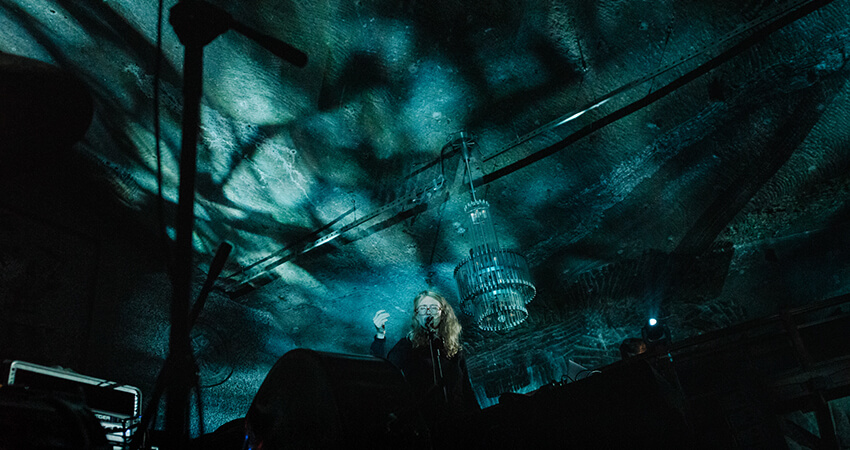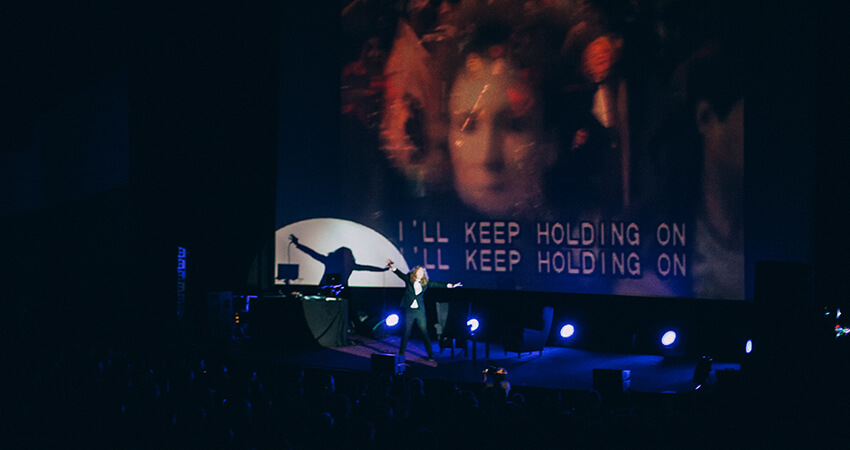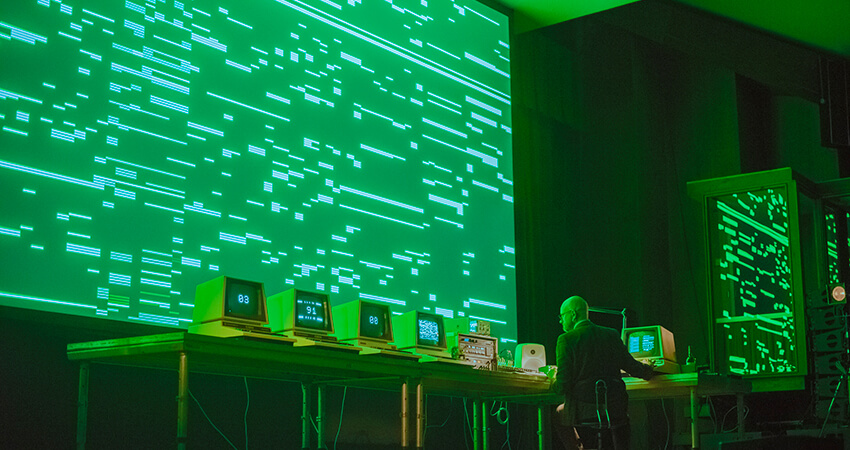Text by CLOT Magazine

Unsound Krakow 2019 closed last 13th October, one of their best editions for the line-up and the theme chosen —Solidarity —. Back in 1989 two major political events changed how we perceive Europe today: the Fall of the Berlin Wall and the first democratic elections in Poland after the end of the Communist Rule that brought Solidarity —the Polish labour union— led a coalition government.
The current environmental and political turmoil in Europe and the rest of the world with the rise of the far-right parties and the reach of plastic pollution in our oceans is at the same time uniting us to fight together against injustices with one word: Solidarity.
Our team arrived on Tuesday just in time to drop into DeForrest Brown Jr‘s talk. DeForrest Brown Jr is a New York-based music writer, curator and media theorist whose practice is inherently radical. In a conversation with CLOT Magazine a few months ago he told us that the contemporary art industry is designed for and by White people free of cultural/familial attachments or significant historical traumas, and thus the expectation of artistic output is similarly devoid of the type of aggression or emotional gravity that would come from a struggling Black artist. In his practice, DeForrest Brown Jr has found new ways of mixing text, storytelling, images, new media and sound to raise awareness about themes of black identity in the world of contemporary art.
And, he did not disappoint us during the presentation of his talk Assembling a Black Counterculture in which, for a White crowd, he discussed the state of Black representation, racism, and appropriation of Black culture. He delivered an intimate talk in which he shared personal history with moments of silence. Assembling a Black Counterculture is the topic of a book he is working on, and that will be published in 2020.
Dreamcrusher was one of our highlights of performances during the early week. Self-described as “nihilist queer revolt musik”, they are becoming one of the key artists in the underground NYC scene. The artist appeared at Manggha stage (the museum of Japanese art and technology originally founded by acclaimed Polish director Andrzej Wajda) as a sort of feral mythological deity, the intense noise performance was a sort of ritualistic awakening to what we were expecting to come.
On Wednesday, we descended into Krakow’s Wieliczka Salt Mine to listen to a Dj set by journalist, producer and DJ Philip Sherburne and Félicia Atkinson. The French electroacoustic artist, poet, and publisher of Shelter Press Félicia Atkinson presented her latest album The Flower & The Vessel, recorded while she was pregnant. The album is an exploration of the relationship between the outer and the inner worlds, of the fragility and responsibility of ‘adding’ something to the world and the Salt Mine, was the perfect scenario to swim into Félicia Atkinsons’ ambient sceneries.
What is an act of creativity in general, whereas it is to make a bouquet, a record or a baby, this consciousness of adding something to the world, the responsibility of it but also the beauty and fragility of it?, Félicia says. The dramatic cave structures carved into the salt mine were magically lit by Marcel Webber (aka MFO), who, year after year, beats himself with his light design for the whole festival.


Metahaven, the design studio mixing filmmaking, writing, and design, to incept politically charges new narratives and scenarios, gave the talk Revisiting Metahaven’s the Sprawl: Propaganda About Propaganda, where they reviewed their 2015’s piece, describes as an unbroken digital scream. For Metahaven, every piece of media, or propaganda, contains in its surface traces of how it was made, provides in its mediatic texture, in the properties of the image, also a message about itself.
The Caretaker (Leyland Kirby) and Weirdcore gave one of the most memorable and heartfelt performances of this year’s edition. The experimental musician was closing a series of six albums released over three years between 2016-2019 which explore through sound themes of loss, memory and the effects of Alzheimer. The show includes Kirby manipulating samples of ballroom 1920s and 1930s music to slowly turn joy and beauty into confusion and horror, the feeling of detachment with reality, unfortunately not because of recreational drugs consumption, but the devastating effects of a no return illness. The live show combined with Weirdcore’s visualisations, drawing on The Caretaker’s iconic cover artwork, created by painter Ivan Seal.
As a distorted mirror image, complementary to the show, Ivan presented a painting installation in an abandoned apartment in Krakow’s Old Town accompanied by a composition of the Caretaker. Seal’s work also deals with memory, loss and decay, as well as the inside lives of objects. In this exhibition, Cukuwruums, the space itself and the items within it become part of the work, exploring the relationship between placed and found objects, foreground and background, as well as toying with the tension between maker and provider, author and interpreter, and creating a temporary place existing alongside and in relation to the live performance.
Probably as memorable was Robert Henke‘s CBM 8032 AV project presentation. The project is an exploration of the beauty of simple graphics and sound, using computers from the early 1980s. The result of three years’ work, the show has been produced entirely using restored Commodore CBM 8032 computers. This work is about the ambivalence between a contemporary aesthetic and the usage of a very limited technology from 40 years ago.
Everything presented within the project could have been done already in 1980, but it needed the cultural backdrop of 2019 to come up with artistic ideas driving it. The long and intense ovation at the end felt a well-earned reward for all these years the project has been in the making, a project that evidences Henke’s endless curiosity and creativity, The set-up that the team from Unsound chose could not have been a better fit: Aula AWF, an untouched hall, dating back to the 1970s, in the middle of the Physical Education Academy. Henke’s appearance on stage dressed up in an 80’s style, dark brown suit, matching the wooden panels and seats in the seminar room added up to the nostalgic feeling of the performance.

Roly Porter and MFO presented Kistvaen, a co-commissioned A/V by Unsound, MIRA festival and Berlin Atonal, just before the expected Sunn O))) appearance 10 years after their last and only visit the festival. Kistvaen, in Porter and MFO ‘s own words, is a performance piece that contrasts primordial motifs—elements and seasons, sun and moon, gods and magic—with that of the 21st century—life in designed environments and an evolving virtual existence… Our pagan roots and technology-driven present are inextricably interwoven.
At the Hotel Forum, nights were spent in the usual craze between many great acts. Emptyset and Objekt X Ezra Miller presented highly expected new audiovisual shows. Terrence Dixon, Sherelle, HHY & The Kampala Unit presenting Omutaba Lithium Blast, and Paula Temple were other highlights with DJ Marcelle probably giving one of our favourite DJ sets of the festival. Wixapol gave a show-off, festive hardcore performance, far away from the boat party we discovered them in one trip to Warsaw a few years back, just when these parties were starting to get a name in the Polish capital.
Unsound always delivers extraordinary moments, for this edition one of the spots was ticked by Chernobyl, a performance of the soundtrack of the series under the same name. The project, a collaboration between composers Hildur Guðnadóttir and Sam Slater, the legendary field recording artist Chris Watson and visual artist Theresa Baumgartner involved sound-tapping Chernobyl’s sister plant in Ukraine and acoustic instruments. The performance, arranged in a semi-abandoned factory was chilling, delicate at moments and overwhelming. During one intense and emotive hour, the audience experienced impotence, fear, ruthlessness, dystopia and collapse using masterful sound design.
The closing concert this year took place in Slowackiego Theatre and the Baltimore duo Matmos performed their album Plastic Anniversary using plastics objects. A beautiful closing night and a different way to denounce how ubiquitous plastic is due to its resistance to many natural processes of degradation.






